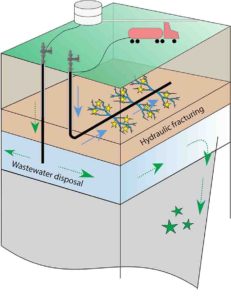
Stanford geoscientists have devised a way of detecting thousands of faint, previously missed earthquakes triggered by hydraulic fracturing, or “fracking.”
The technique can be used to monitor seismic activities at fracking operations to help reduce the likelihood of bigger, potentially damaging earthquakes from occurring, according to the new study.
“These small earthquakes may act like canaries in a coalmine,” said study co-author William Ellsworth, a professor (research) of geophysics at Stanford’s School of Earth, Energy & Environmental Sciences. “When they happen, they should be viewed as cautionary indicators of underground conditions that could lead to larger earthquakes.”
Fracking involves injecting high-pressure fluid underground to crack open rocks and release the natural gas trapped inside. As the rocks crack, they produce tiny earthquakes that were typically too small to be detected – until now.
“In our study, you can actually see individual earthquakes occurring next to the section of a well that’s being fracked,” said Stanford PhD student Clara Yoon, lead author of the study published in the Journal of Geophysical Research.
Arkansas earthquakes
In October 2010, residents near an Arkansas natural gas field were shaken by a magnitude 4 earthquake that was followed by two larger aftershocks in February 2011.
Scientists say these large earthquakes were caused by injections of wastewater from fracking sites into deep underground wells, and not by fracking operations closer to the surface.
“These were some of the first earthquakes related to shale-gas development to draw national attention,” Ellsworth said.
Earthquakes of magnitude 4 and higher have subsequently rattled Oklahoma, Texas and other gas- and oil-producing states.
Data mining
Using an advanced data-mining algorithm developed by Yoon and her colleagues, the Stanford team conducted a retrospective analysis of seismic activity in Arkansas prior to the magnitude 4 event. The algorithm uses earthquake-pattern recognition to generate detailed records of seismicity.
The analysis tracked seismic events generated at production wells that utilized fracking and at deeper wastewater-disposal wells nearby.
“We were interested in how the sequence that led to the magnitude 4 earthquake got started,” Yoon said. “We looked at the earliest period of seismic activity in 2010, from June 1 to September 1, when wastewater injection was just beginning.”
When Yoon ran the algorithm on this dataset, she discovered more than 14,000 small, previously unreported earthquakes. By comparing the timing and location of the tremors with fluid-injection data provided by the state of Arkansas, Yoon was able to demonstrate that most of the earthquakes were the direct result of fracking operations at 17 of the 53 production wells.
“That was a surprise,” said co-author Gregory Beroza, the Wayne Loel Professor of Geophysics at Stanford. “It had been thought, and we thought, that early earthquakes in this area were related to wastewater injection. But we found that the majority were caused by fracking.”
Persistent quakes
Many of the fracking-induced earthquakes were also bigger and more persistent that expected – unusual properties indicating potential trouble ahead.
Earthquakes generated by fracking are typically no larger than magnitude 0. That’s equivalent to the amount of energy released when a milk carton hits the floor after falling off a counter.
But several earthquakes observed in the study were magnitude 1, which is 31 times stronger than a magnitude 0 quake. A few were above magnitude 2, which is 1,000 times stronger than magnitude 0.
Most fracking-induced quakes occur near the well and dissipate quickly. But some of the Arkansas earthquakes were located far from the wellbore and continued weeks after fracking operations had ended.
“We were particularly surprised by the size and persistence of the seismicity,” Ellsworth said. “When earthquakes during fracking operations are larger than expected and persist for weeks, it indicates a high level of stress in that area. Faults under high stress are unstable and can slip, triggering larger earthquakes.”
The fact that fracking near wastewater wells induced thousands of earthquakes – too many, too big and lasting too long – was a red flag that stress conditions deeper down were also primed to create the instability that triggered larger earthquakes, he added.
“We want to encourage continuous seismic monitoring before fracking operations start, while they’re in progress and after they’ve finished,” Beroza said. “The algorithm Clara developed offers an efficient, cost-effective method for getting more information out of existing data, so that in the future informed decisions can be made that reduce the chance of larger earthquakes from happening.”
Reference:
Clara E. Yoon et al. Seismicity During the Initial Stages of the Guy-Greenbrier, Arkansas, Earthquake Sequence, Journal of Geophysical Research: Solid Earth (2017). DOI: 10.1002/2017JB014946
Note: The above post is reprinted from materials provided by Stanford University.










